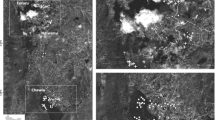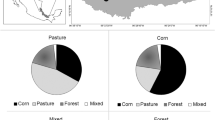Abstract
Tropical agroecosystems cover an increasingly large proportion of the Earth’s terrestrial surface. Yet, relatively little is known about the factors that influence their avifauna, especially in areas of high human population density. The potential of tropical farmland for sustaining bird biodiversity, including forest birds, can be influenced by habitat structure and the distance from the nearest forest. We investigated the effect of these two factors on the bird community in the farmland near Kakamega Forest, Kenya. Using point counts, we assessed the number of bird species and individuals on 56 study plots in distances up to about 2,100 m from the forest. We observed a total of 96 bird species in the farmland, 22 of which were forest, 58 shrub-land, and 16 open-country species. High vertical vegetation heterogeneity and a large number of woody plant individuals were related to high species richness of forest and shrub-land birds, whereas open-country birds avoided such areas. The species richness and total number of forest birds declined with increasing distance to the forest. A comparison with the bird community within Kakamega Forest indicated that only a fraction of the forest species could be sustained in the farmland. This suggests that agroecosystems with a diverse habitat structure can support a high diversity of birds, but have only a limited capacity to compensate for forest loss.


Similar content being viewed by others
References
Balmford A, Moore JL, Brooks T, Burgess N, Hansen LA, Williams P, Rahbek C (2001) Conservation conflicts across Africa. Science 291:2616–2619 doi:https://doi.org/10.1126/science.291.5513.2616
Beentje H (1994) Kenya trees, shrubs and lianas. National Museums of Kenya, Nairobi
Bennun LC (2000) Assessing and monitoring bird populations in Africa: an overview. Ostrich 71:214–215
Bennun L, Njoroge P (1999) Important bird areas in Kenya. Nature Kenya, Nairobi
Bennun LC, Dranzoa C, Pomeroy D (1996) The forest birds of Kenya and Uganda. J East Afr Nat Hist 85:23–48
Berens DG, Farwig N, Schaab G, Böhning-Gaese K (2007) Exotic guavas are foci of forest regeneration in kenyan farmland. Biotropica. doi:https://doi.org/10.1111/j.1744-7429.2007.00338.x
Bibby CJ, Burgess ND, Hill DA, Mustoe SH (2000) Bird census techniques. Academic, London
BirdLife International (2006) Species factsheets. Available online at http://www.birdlife.org
Blackett HL (1994) Forest inventory report no. 3 Kakamega. Forest Dept./KIFCON, Nairobi
Bleher B, Uster D, Bergsdorf T (2006) Assessment of threat status and management effectiveness in Kakamega Forest, Kenya. Biodivers Conserv 15:1159–1177 doi:https://doi.org/10.1007/s10531-004-3509-3
Bradley PN (1988) Methodology for woodfuel development planning in the Kenyan highlands. J Biogeogr 15:157–164
Brookfield H, Parsons H, Brookfield M (eds) (2003) Agrodiversity: learning from farmers across the world. United Nations University Press, Tokyo
Burnham KP, Anderson DR (2002) Model selection and multi-model inference, 2nd edn. Springer, New York Berlin Heidelberg
Chapman CA, Chapman J (1999) Forest restoration in abandoned agricultural land: a case study from East Africa. Conserv Biol 13:1301–1311 doi:https://doi.org/10.1046/j.1523-1739.1999.98229.x
Crick HQP (1992) A bird-habitat coding system for use in Britain and Ireland incorporating aspects of land management and human activity. Bird Study 39:1–12
Colwell RK (2005) EstimateS: statistical estimation of species richness and shared species from samples. Version 7.5. Available online at http://purl.oclc.org/estimates
Conelly WT, Chaiken MS (2000) Intensive farming, agro-diversity, and food security under conditions of extreme population pressure in western Kenya. Hum Ecol 28:19–51
Daily GC, Ehrlich PR, Sanchez-Azofeifa GA (2001) Countryside biogeography: use of human-dominated habitats by the avifauna of southern Costa Rica. Ecol Appl 11:1–13
EBCC (2007) Trends of common birds in Europe, 2007 update. Available online at http://www.ebcc.info/pecbm.html
Elgood JH, Sibley FC (1964) The tropical forest edge avifauna of Ibadan, Nigeria. Ibis 106:221–248
Eshiamwata GW, Berens DG, Bleher B, Dean WRJ, Böhning-Gaese K (2006) Bird assemblages in isolated Ficus trees in Kenyan farmland. J Trop Ecol 22:723–726
Estrada A, Coates-Estrada R, Merrit DA (1997) Anthropogenic landscape change and avian diversity at Los Tuxtlas, Mexico. Biodivers Conserv 6:19–43 doi:https://doi.org/10.1023/A:1018328930981
Farwig N, Böhning-Gaese K, Bleher B (2006) Enhanced seed dispersal of Prunus africana in fragmented and disturbed forests? Oecologia 47:238–252. doi:https://doi.org/10.1007/s00442-005-0288-9
Fry CH, Keith S (eds) (2004) The birds of Africa, vol VII. Christopher Helm, London
Fry CH, Keith S, Urban KE (eds) (1988) The birds of Africa, vol III. Academic, London
Fry CH, Keith S, Urban KE (eds) (2000) The birds of Africa, vol VI. Academic, London
Greenberg R, Bichier P, Angon AC, Reitsma R (1997a) Bird populations in shade and sun coffee plantations in central Guatemala. Conserv Biol 11:448–459 doi:https://doi.org/10.1046/j.1523-1739.1997.95464.x
Greenberg R, Bichier P, Sterling J (1997b) Bird populations in rustic and planted shade coffee plantations of eastern Chiapas, Mexico. Biotropica 29:501–514 doi:https://doi.org/10.1111/j.1744-7429.1997.tb00044.x
Harvey CA, Medina A, Sánchez DM, Vílchez S, Hernández B, Saenz JC, Maes JM, Casanoves F, Sinclair FL (2006) Patterns of animal diversity in different forms of tree cover in agricultural landscapes. Ecol Appl 16:1986–1999
Holl KD (1998) Do bird perching structures elevate seed rain and seedling establishment in abandoned tropical pastures? Restor Ecol 6:253–261 doi:https://doi.org/10.1046/j.1526-100X.1998.00638.x
Holl KD, Loik ME, Lin EH, Samuels IA (2000) Tropical montane forest restoration in Costa Rica: overcoming barriers to dispersal and establishment. Restor Ecol 8:339–349 doi:https://doi.org/10.1046/j.1526-100x.2000.80049.x
Hughes JB, Daily GC, Ehrlich PR (2002) Conservation of tropical forest birds in countryside habitats. Ecol Lett 5:121–129 doi:https://doi.org/10.1046/j.1461-0248.2002.00294.x
James FC, Shugart HH (1970) A quantitative method of habitat description. Audubon Field Notes 24:727–736
Johnson JB, Omland KS (2004) Model selection in ecology and evolution. Trends Ecol Evol 19:101–108
Keith S, Urban KE, Fry CH (eds) (1992) The birds of Africa, vol IV. Academic, London
KIFCON (1994) Kakamega guide. The official guide. Kenya Indigenous Forest Conservation Programme, Nairobi
Kofron CP, Chapman A, (1995) Deforestation and bird species composition in Liberia, West Africa. Trop Zool 8:239–256
Kokwaro JO (1988) Conservation status of the Kakamega Forest in Kenya. The Eastern most relic of the equatorial rainforest of Africa. Monogr Syst Bot Mo Bot Gard 25:471–489
Kujawa K, Tryjanowski P (2000) Relationships between the abundance of breeding birds in Western Poland and the structure of agricultural landscape. Acta Zool Acad Sci Hung 46:103–114
Luck GW, Daily GC (2003) Tropical countryside bird assemblages: richness, composition and foraging differ by landscape context. Ecol Appl 13:235–247
MacArthur RH, MacArthur JW (1961) On bird species diversity. Ecology 42:594–598
Manning AD, Fischer J, Lindenmayer DB (2006) Scattered trees are keystone structures—implications for conservation. Biol Conserv 132:311–321
Martinez-Garza C, Gonzalez-Montagut R (1999) Seed rain from forest fragments into tropical pastures in Los Tuxtlas, Mexico. Plant Ecol 145:255–265 doi:https://doi.org/10.1023/A:1009879505765
Michaels HL, Cully JF (1998) Landscape and fine scale habitat associations of the Loggerhead shrike. Wilson Bull 110:474–482
Naidoo R (2004) Species richness and community composition of songbirds in a tropical forest-agricultural landscape. Anim Conserv 7:93–105 doi:https://doi.org/10.1017/S1367943003001185
Nichols JD, Boulinier T, Hines JE, Pollock KH, Sauer JR (1998) Inference methods for spatial variation and community composition when not all species are detected. Conserv Biol 12:1390–1398 doi:https://doi.org/10.1046/j.1523-1739.1998.97331.x
Ortiz-Pulido R, Laborde J, Guevara S (2000) Fruit-eating habits of birds in a fragmented landscape: Implications for seed dispersal. Biotropica 32:473–488 doi:https://doi.org/10.1111/j.1744-7429.2000.tb00494.x
Petit LJ, Petit DR, Christian DG, Powell HD (1999) Bird communities of natural and modified habitats in Panama. Ecography 22:292–304 doi:https://doi.org/10.1111/j.1600-0587.1999.tb00505.x
Plumptre AJ (1997) Shifting cultivation along the trans-African highway and its impact on the understorey bird community in the Ituri Forest, Zaire. Bird Conserv Int 7:317–329
Savalli UM (1989) Checklist of bird of the Kakamega Forest and National Reserve. Available online at http://www.uky.edu/~cfox/Students/Savalli/KakaBirdList.html
Söderström B, Kiema S, Reid RS (2003) Intensified agricultural land-use and bird conservation in Burkina Faso. Agric Ecosyst Environ 99:113–124 doi:https://doi.org/10.1016/S0167-8809(03)00144-0
Tejeda-Cruz C, Sutherland WJ (2004) Bird responses to shade coffee production. Anim Conserv 7:169–179 doi:https://doi.org/10.1017/S1367943004001258
Thiollay JM (1995) The role of traditional agroforests in the conservation of rain-forest bird diversity in Sumatra. Conserv Biol 9:335–353 doi:https://doi.org/10.1046/j.1523-1739.1995.9020335.x
Tiffen M, Mortimore M, Gichuki F (1994) More people, less erosion. Environmental recovery in Kenya. Wiley, Chichester
Tryjanowski P (1999) Effect of habitat diversity on breeding birds: comparison of farmland bird community in the region of Wielkopolska (W. Poland) with relevant data from other European studies. Pol J Ecol 47:153–174
Tsingalia MH (1990) Habitat disturbance, severity and patterns of abundance in Kakamega Forest, Western Kenya. Afr J Ecol 28:213–226
Urban EK, Fry CH, Keith S (eds) (1986) The birds of Africa, vol II. Academic, London
Urban EK, Fry CH, Keith S (eds) (1997) The birds of Africa, vol V. Academic, London
Vandermeer J, Perfecto I (1997) The agroecosystem: a need for the conservation biologist’s lens. Conserv Biol 11:591–592 doi:https://doi.org/10.1046/j.1523-1739.1997.07043.x
Waltert M (2000) Diversity and structure of a bird community in a logged forest in south-east Cote d’lvoire. PhD thesis, University of Göttingen, Germany
Waltert M, Bobo SK, Saing NM, Fermon H, Mühlenberg M (2005) From forest to farmland: habitat effects on Afrotropical forest bird diversity. Ecol Appl 15:1351–1366
Wright SJ (2005) Tropical forests in a changing environment. Trends Ecol Evol 20:553–560 doi:https://doi.org/10.1016/j.tree.2005.07.009
Zimmerman DA, Turner DA, Pearson DJ (1999) Birds of Kenya and northern Tanzania. Field guide edition. Princeton University Press, New Jersey
Acknowledgments
We thank B. Bleher for support during study preparation and field work, N. Sajita for assistance with field work and G. Schaab for providing distances of plots to forest. N. Farwig kindly provided access to bird survey data. We thank D. Berens for useful input. The people living around Kakamega Forest have our sincere gratitude for their exceptional hospitality and for generously allowing unrestricted access to their land. We thank the Bernd Woick GmbH for sponsoring field equipment. Financial support was provided by the BMBF (Biota East Africa 01LC0025). The field work complied with the current laws of Kenya.
Author information
Authors and Affiliations
Corresponding author
Additional information
Communicated by C. Rahbek.
Electronic supplementary material
Below is the link to the electronic supplementary material.
Table S1
Bird species observed on the 56 study plots, sorted according to total observations and mean number of observations per plot and census. Nomenclature and habitat preferences (F=forest species, S=shrub-land species, O=open country species) after Zimmerman et al. (1999).
Table S2
Habitat variables retained for the different bird groups after the first model selection process. # woody plants: number of woody plant individuals; habitat diversity: Shannon-Wiener index of habitat types; hedges: length of hedge rows; horizontal VH: horizontal vegetation heterogeneity; vertical VH: vertical vegetation heterogeneity. All variables except # woody plant species and vertical vegetation heterogeneity were log (x + 1) transformed.
Rights and permissions
About this article
Cite this article
Laube, I., Breitbach, N. & Böhning-Gaese, K. Avian diversity in a Kenyan agroecosystem: effects of habitat structure and proximity to forest. J Ornithol 149, 181–191 (2008). https://doi.org/10.1007/s10336-007-0258-6
Received:
Revised:
Accepted:
Published:
Issue Date:
DOI: https://doi.org/10.1007/s10336-007-0258-6




